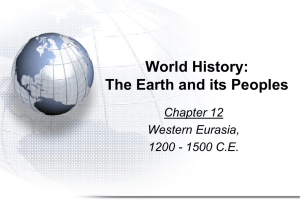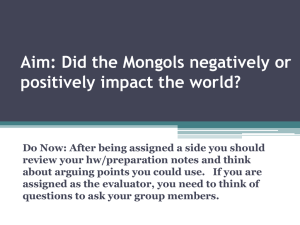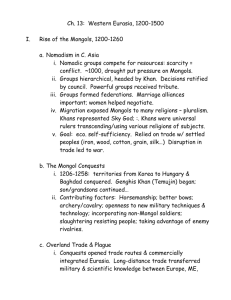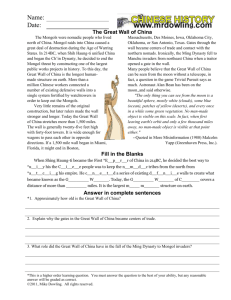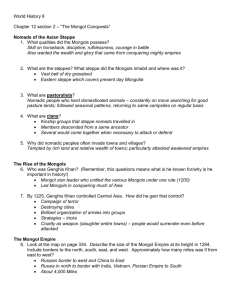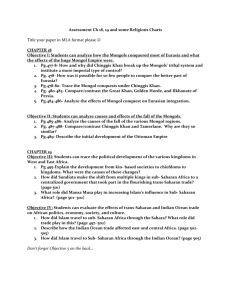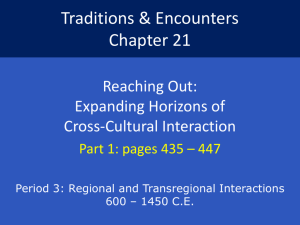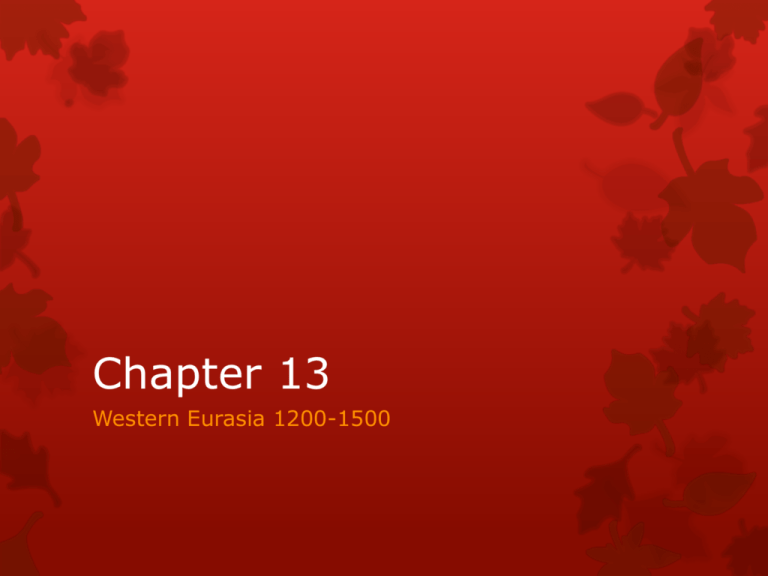
Chapter 13
Western Eurasia 1200-1500
Nomadism in Central Asia
Agriculture is difficult on the steppes and deserts of Central
Asia, so the inhabitants became pastoral nomads.
Occasionally different nomadic groups would come into
contact while seeking the same resources, and the outcome
was usually war, alliance, or both.
Since early times, Central Asian societies had been
permeated by the idea of world rulership by a khan, who,
with the aid of his shamans, would speak to and for an
ultimate god.
Generally men tended the herds in the pastures, and
women were responsible for breeding, milking, shearing,
etc.
Nomads strove for economic self-sufficiency by attempting
to restrict their diet to foods they could provide and by
wearing clothes produced by pastoral animals.
However, nomads never lived completely independent of
settled regions. Iron was one important material nomads
needed to acquire through trade with settled regions.
Nomads were responsible for the transfer of goods,
information, and technology across Eurasia.
The Mongol Conquests
When Temujin was a boy his father was murdered by a
rival group.
At 15, Temujin sought refuge with the Keraits. During his
time with them, Temujin learned the leadership skills
that would be fundamental to the power and scope of
the empire he would build.
After conquering rival clans, Temujin was acknowleged
as Genghis Khan, or supreme leader, of the Mongols and
their allies in 1206.
Shortly after this, Genghis began to carry out his plan to
convince the kingdoms of Eurasia to surrender tribute to
him.
Genghis and his sons/grandsons successfully conquered
much of Eurasia over the next 30 years.
Overland Trade and the Plague
Mongol control of a vast area of land encouraged
trade of goods such as silk as well as a merging of
artistic styles.
This trade was protected by Mongol control of the
overland routes and promoted by Mongol tax
policies, but it was carried out by a collection of
very different peoples from all over Eurasia.
Mongol policies also widened the steady stream of
knowledge between Europe and the Middle East.
This trade also led to the spread of the bubonic
plague as well as other diseases.
Mongol Rivalry
By 1260 two distinct Mongol realms had been
established in western Eurasia: the Il-khan Empire
(Armenia, Azerbaijan, Mesopotamia, and Iran) and the
Golden Horde (Russia).
The leader of the Golden Horde converted to Islam and
decided to avenge the murder of the last Abbasid caliph
(murdered by the Il-khan).
There were tensions between Mongols and Muslims due
to differing beliefs (ex. idol worship, animal slaughter)
The Il-khan were Buddhists, and Europeans attempted
to join with them to drive Muslims out of contested
religious sites.
Before this alliance could be finalized, a new Il-khan
ruler (Ghazan) converted to Islam, and the Il-khans
declared themselves the protectors of Islam. All Mongols
were ordered to convert.
Map: The Mongol Empire
Copyright © Houghton Mifflin Company. All rights reserved.
Islam and the State
The Il-khans used tax farming to generate income.
In tax farming, the government sold tax-collecting
contracts to small corporations who promised to collect
the most money.
The tax farmers could use whatever means they chose
to collect taxes and could keep anything over the
contracted amount.
The short-term results for the government were good,
but the high tax rate led to debt, servitude, inflation,
and other economic problems.
Ghazan became Il-khan and converted in the midst of
this crisis. He lessened the government’s tax demands
and sought new methods of economic management.
He decided to try the Chinese practice of paper money,
but the people had no confidence in it, and the economy
sank into a depression that lasted until the end of the Ilkhan period.
Islam and the State
As the power of the Il-khans in the Middle East and the
Golden Horde in Russia weakened in the 14th century, a
new power emerged in Central Asia.
Under the leader Timur, the Jagadai Khanate drew on
the political traditions of the Mongols and on Islam.
Much of the Middle East was united under his rule, and
he hoped to add China.
The Timurids (Timur’s descendants):
Deepened and consolidated Sunni Islamic influence in the
Middle East.
Laid the groundwork for the later establishment in India of
a Muslim Mongol regime, the Mughals.
Timur was the last great Central Asian conqueror. After
his time Central Asia was no longer the crossroads of
Eurasia, as it had been since the earliest times.
Art and Science in Islamic Eurasia
The Il-khans and Timurids presided over a brilliant
period in Islamic civilization.
History
Juvaini – described the rise of Mongols under Genghis Khan
Rashid al-Din – attempted first history of the world
Astronomy
Tried to reconcile Ptolemy’s geocentric theory
Nasir al-Din made a breakthrough that eventually reached
Copernicus.
Calendars
Navigational equipment
Mathematics
Complex algebra and geometry
Spread Indian (Arabic) number system
decimals
Depictions of Europeans in Rashid al-Din
Depictions of Europeans in
Rashid al-Din
A Persian Jew who converted to
Islam, Rashid al-Din (ca. 12471318) undertook to explain the great
variety of cultures by writing a
history of the world including a
history of the Franks, illustrated here
with images of Western popes (left)
conferring with Byzantine emperors
(right). (Topkapi Palace Museum)
Copyright © Houghton Mifflin Company. All rights reserved.
Effects of Mongol Rule
in Persia and Russia
In Persia, the Il-khan were very involved in local society
and eventually converted to Islam.
In Russia, the Golden Horde was removed from Russian
society, both physically and politically, and never
developed an identification with the culture.
Despite this difference, there are some similar effects:
The local language emerged as a literary language.
Traditional elites were weakened.
The local religion remained powerful.
The dominant capital city lost power and new cities gained
influence.
Centralization increased. (In Russia, Ivan III, the prince of
Moscow, established himself as an autocratic ruler.)
Golden Horde Invading Europe (stopped in Lithuania)
Effects of the Mongols in Europe
While western Europe was busy with conflict between
the Pope and the Holy Roman Emperor, the kingdoms of
eastern Europe had to deal with the Golden Horde on
their own.
Some eastern European princes chose to capitulate and
went to the capital and declared themselves slaves of
Batu.
When eastern Europe was attacked by Mongol forces,
Europe panicked. Some theories:
Mongols had bodies that were part dog
Mongols came from hell
The Mongols were the lost tribes of Israel. Jews who were
thought to be in secret alliance with the invaders were
lynched.
When the Great Khan Ogodei died, the onslaught
suddenly stopped as the Mongol princes returned to
Mongolia to elect a new Khan.
Effects of the Mongols in Europe
Through contact, eventually European terror of Mongols
was replaced with awe and idealization of the wealth and
power of the Mongol khanates.
More Asian knowledge will make its way into Europe.
Eurasian geography
Mining and use of coal
Movable type
Higher math
gunpowder
The Mongol invasion (along with the Bubonic Plague)
ignited a storm of religious questioning and anxiety.
Ottoman Turks moved into the region (and eventually
conquered the Byzantine empire, renaming
Constantinople Istanbul)

